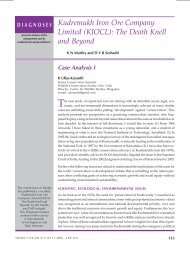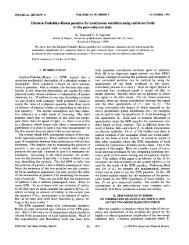Phase Transfer Catalysis - Publications of the IAS Fellows
Phase Transfer Catalysis - Publications of the IAS Fellows
Phase Transfer Catalysis - Publications of the IAS Fellows
You also want an ePaper? Increase the reach of your titles
YUMPU automatically turns print PDFs into web optimized ePapers that Google loves.
a-eliminations, hydrolysis reactions, and so on. C-, 0-, and<br />
JV-alkylations find wide applications in a variety <strong>of</strong> reactions<br />
useful in <strong>the</strong> pharmaceutical and agro-chemical industries. PT<br />
catalyzed alkylations <strong>of</strong> weak acids like aliphatic alcohols<br />
(PIG - 18) and very weak CH- and NH-acids (pI& - 22-25)<br />
are possible in <strong>the</strong> presence <strong>of</strong> concentrated (50%) aqueous<br />
NaOH or solid I&COs. An advantage <strong>of</strong> carrying out reactions<br />
in <strong>the</strong> presence <strong>of</strong> a base in biphasic systems is that it<br />
prevents hydrolysis <strong>of</strong> <strong>the</strong> organic reactant, since OH- has<br />
limited solubility in <strong>the</strong> organic phase, whereby <strong>the</strong> organic<br />
substrate is not subject to <strong>the</strong> alkaline conditions present in<br />
<strong>the</strong> aqueous phase. The use <strong>of</strong> a PT catalyst also obviates <strong>the</strong><br />
need for expensive and corrosive reducing agents like sodium<br />
azide and sodium hydride.<br />
Despite wide-scale applications <strong>of</strong> PTC reactions in <strong>the</strong><br />
presence <strong>of</strong> a base, <strong>the</strong> mechanism <strong>of</strong> <strong>the</strong>se reactions is not<br />
clear. PTC systems operate via different mechanisms in <strong>the</strong><br />
presence <strong>of</strong> bases (Makosza, 1977). However, it is an established<br />
fact that in most cases it does not involve <strong>the</strong> transfer<br />
<strong>of</strong> OH- by <strong>the</strong> quat as a Q+ OH- complex, since Q+ OHis<br />
highly hydrophilic and has very limited solubility in <strong>the</strong> organic<br />
phase. Alkylation reactions that have been proposed to<br />
be mediated through a Q+ OH- intermediate probably involve<br />
reaction between Q+ OH- and <strong>the</strong> organic substrate at<br />
<strong>the</strong> liquid-liquid interface. Rabinovitz et al. (19861 review <strong>the</strong><br />
effect <strong>of</strong> anions, base concentration, and water in PTC/OHsystems.<br />
Makosza’s interfacial mechanism (Makosza, 1975), based on<br />
substrate deprotonation by <strong>the</strong> base, is <strong>the</strong> most widely accepted<br />
mechanism. It has been experimentally validated for<br />
alkylation reactions using PTC/OH- (Solar0 et al., 1980;<br />
Balakrishnan et al., 1993). Also, carbene reactions follow a<br />
different mechanism. The interfacial mechanism involves deprotonation<br />
<strong>of</strong> <strong>the</strong> organic substrate (ROH) at <strong>the</strong> interface<br />
by <strong>the</strong> hydroxide ion (present in <strong>the</strong> aqueous phase), forming<br />
Na+ OR- at <strong>the</strong> interface. Na+ OR- is essentially insoluble<br />
in ei<strong>the</strong>r phase (Makosza and Bialecka, 1977) and is immobilized<br />
at <strong>the</strong> interface. The PT catalyst functions to draw <strong>the</strong><br />
organic anion into <strong>the</strong> bulk organic phase as a Q+ OR- ion<br />
pair, liberating Na+X- into <strong>the</strong> aqueous phase. Q+OR<strong>the</strong>n<br />
reacts with <strong>the</strong> organic substrate R’Y to form R’-QR.<br />
Gas-liquid PTC<br />
The mechanism <strong>of</strong> GLPTC differs from traditional PTC<br />
mechanisms in liquid-liquid and solid-liquid systems. No one<br />
mechanism has been proposed for GLPTC because <strong>of</strong> <strong>the</strong><br />
different types <strong>of</strong> reaction involved. However, it is clear that<br />
<strong>the</strong> gaseous reactant has to diffuse through <strong>the</strong> molten liquid<br />
film <strong>of</strong> <strong>the</strong> PT catalyst, with reaction occurring simultaneously<br />
between <strong>the</strong> diffusing species and <strong>the</strong> catalyst. The<br />
exact mechanism <strong>of</strong> transfer <strong>of</strong> <strong>the</strong> solid reagent into <strong>the</strong> catalyst<br />
phase and reaction with <strong>the</strong> gaseous reagent is not understood<br />
well, especially when <strong>the</strong> solid reagent is a base like<br />
K.$03, with <strong>the</strong>? organic and nucleophilic reagents present<br />
in <strong>the</strong> gaseous phase. For example, in <strong>the</strong> PEG catalyzed isomerization<br />
<strong>of</strong> allylbenzene, Neumann and Sasson (1985a)<br />
suggest <strong>the</strong> formation <strong>of</strong> a PEG--IS&O3 complex that adsorbs<br />
<strong>the</strong> organic substrate, followed by reaction at <strong>the</strong> catalyst<br />
interface.<br />
When <strong>the</strong> molten <strong>the</strong>rmally stable PT catalyst is supported<br />
on an inert matrix, <strong>the</strong> solid phase functions strictly as a sup-<br />
port for <strong>the</strong> catalyst. Separation <strong>of</strong> <strong>the</strong> catalyst from <strong>the</strong> reaction<br />
mixture is easier in this case. Reaction is diffusion controlled<br />
and excess catalyst does not affect <strong>the</strong> conversion<br />
above a certain value due to congestion <strong>of</strong> pores and reduction<br />
<strong>of</strong> surface area. Diffusional limitations prevent <strong>the</strong><br />
reagents from reaching <strong>the</strong> catalyst bound deep within <strong>the</strong><br />
zeolite pores in <strong>the</strong> limited contact time between <strong>the</strong> solid<br />
phase and <strong>the</strong> gaseous reactants (Angeletti et al., 1984).<br />
Modeling <strong>of</strong> PTC Reactions<br />
General considerations in PTC modeling<br />
In modeling heterogeneous reactions, <strong>the</strong> interactions <strong>of</strong><br />
diffusion with chemical reaction become important when <strong>the</strong><br />
relative rates <strong>of</strong> reaction and diffusion are <strong>of</strong> <strong>the</strong> same order<br />
<strong>of</strong> magnitude. For example, PTC has been found to enhance<br />
not only slow reactions (kinetic regime) but also fast reactions,<br />
where reaction occurs partially or entirely in <strong>the</strong> diffusion<br />
film. In fast reactions, diffusion and chemical reaction<br />
occur simultaneously and reaction may occur partly or completely<br />
in <strong>the</strong> organic film. Thus, in general, in modeling PTC<br />
systems, it is necessary to consider <strong>the</strong> individual steps that<br />
comprise <strong>the</strong> PTC cycle, namely interphase mass transfer, ion<br />
exchange, and <strong>the</strong> main organic phase reaction. The rate <strong>of</strong><br />
<strong>the</strong> overall process depends on <strong>the</strong> relative rates <strong>of</strong> <strong>the</strong> individual<br />
steps. Although a large number <strong>of</strong> articles have been<br />
published on <strong>the</strong> syn<strong>the</strong>tic applications <strong>of</strong> PTC in <strong>the</strong> last<br />
three decades, only a handful <strong>of</strong> <strong>the</strong>se report any engineering<br />
analysis <strong>of</strong> <strong>the</strong> complex PTC cycle. Melville and Goddard<br />
(1990) stress <strong>the</strong> importance <strong>of</strong> convection, diffusion, and reaction<br />
in a PTC system by defining important dimensionless<br />
parameters like <strong>the</strong> Damkohler number (&z) and <strong>the</strong> Peclet<br />
number (Pe) that characterize <strong>the</strong> relative importance <strong>of</strong> diffusion<br />
vs. reaction and convection vs. diffusion, respectively,<br />
in a PTC system. Interphase transport <strong>of</strong> species across <strong>the</strong><br />
interface from one well-mixed bulk phase to ano<strong>the</strong>r is conveniently<br />
quantified by defining an overall mass-transfer coefficient,<br />
which is a combination <strong>of</strong> <strong>the</strong> individual local<br />
mass-transfer coefficients defined for each phase, with no<br />
mass-transfer resistance assumed at <strong>the</strong> interface itself. The<br />
compositions on ei<strong>the</strong>r side <strong>of</strong> <strong>the</strong> interface can be related by<br />
equilibrium constants or partition coefficients, which are <strong>of</strong>ten<br />
assumed to be independent <strong>of</strong> phase composition in most<br />
modeling studies. However, in most kinetic and modeling<br />
studies, <strong>the</strong> kinetics <strong>of</strong> ion exchange, quat partitioning equilibria,<br />
and interphase mass-transfer steps are ignored and <strong>the</strong><br />
organic reaction is assumed to be <strong>the</strong> rate controlling step,<br />
giving<br />
where <strong>the</strong> pseudo-first-order constant ko,,s (l/s) is a linear<br />
function <strong>of</strong> <strong>the</strong> active catalyst concentration CQyorg. We<br />
should point out at this stage that in most <strong>of</strong> <strong>the</strong> modeling in<br />
this article, rates have been written in terms <strong>of</strong> <strong>the</strong> rate <strong>of</strong><br />
change <strong>of</strong> concentration <strong>of</strong> species with time, which is strictly<br />
valid only for batch systems. Since most PTC systems are traditionally<br />
run in batch systems, such an analysis is most helpful.<br />
However, in case <strong>the</strong>se models are to be adapted to continuous<br />
systems, <strong>the</strong> design equations for a continuous reactor<br />
would use a similar analysis with - rA representing <strong>the</strong><br />
rate <strong>of</strong> disappearance <strong>of</strong> reagent A.<br />
AIChE Journal March 1998 Vol. 44, No. 3 619
















